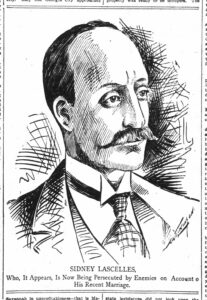
Who was the dead swindler on a pedestal in an Asheville funeral home?
“I don’t care if he never gets buried, if it is he,” Louisiana told the Virginian-Pilot newspaper on July 14, 1905. “All I want is to make sure that the man whose body is now at the North Carolina resort is the body of the man I married. I want to make sure that I am free from him forever.”
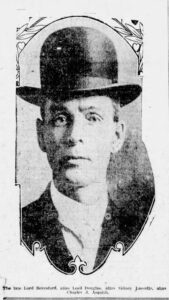
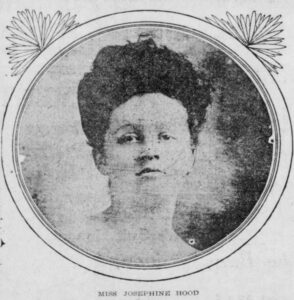
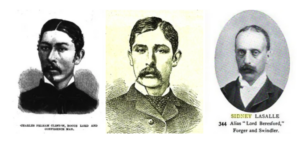
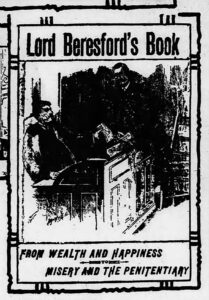
On Friday, Oct. 28, 1904, an Englishman “of refinement and culture” died in a boarding house on Montford Avenue in Asheville. His death certificate, noting a death date of Nov. 10, 1902, was not completed until May 18, 1910. The local health official noted in 1910 that, “I am reliably informed that (the patient) died of pulmonary tuberculosis. … His physician having since died.”
In the almost six years between the man’s death and the completion of his death certificate, his body, clothed in his finest evening wear, silk hat atop his “slightly balding” head, mustache groomed and waxed, and cane in hand, reposed on a pedestal in a room at Asheville’s Noland-Brown funeral home, an advertisement for the embalming department of the establishment.
Upon his arrival in Asheville, just a week or so before his death, the soon-to-be-corpse presented himself as Charles H. Asquith, a middle-aged, wealthy cotton broker and cousin to the former English Home Secretary (and eventual Prime Minister), Herbert Henry Asquith. But, when Asheville authorities sent a cable telegram to Herbert informing him of his cousin’s demise and asking what should be done with his body, the only reply received was that “the deceased was not known.” Follow-up cablegrams were sent to two banks in London that Asquith had given as references. The same replies followed.
Asheville residents reveled in the mystery of the well-dressed stranger’s identity. He had arrived in the city just a week before his death from Newport News, Virginia. He had been accompanied by Dr. G.E. Newby, who had been caring for him in Newport News, and had advised Asquith that the cool mountain air might provide respite for his consumptive symptoms. This proved not to be the case.
Though Asquith had resided in Virginia for only a couple months, he had already “made numerous friends about the city,” including two Englishmen, J.G. Hunter and Walter Charnely. As Asquith prepared to leave Asheville, he reached out to his friend, Charnely, to let him know that the checks he had expected from London had not arrived to pay for his travel. Charnely wired him $300. (The equivalent of about $10,000 in 2022 dollars.)
Though Asquith had trunks of high fashion clothing and traveled like someone who was wealthy and well-connected, he had no money among his possessions, which also left few clues as to his true identity. Photographs of his embalmed body were said to have been taken and sent to London for publication. The local undertakers released a physical description, hoping that someone might recognize Asquith.
Several months passed before a banker from Waco, Texas, on a visit to the Asheville funeral home, claimed that he recognized the corpse as a man “who had spent some time in Waco selling a powder to put in gasoline to prevent explosions.” Still, unable to supply a name for the powder salesman, he remained unidentified.
Then, in July 1905, a letter from Mrs. Louisiana Hobbs Douglas of Lambert’s Point, Virginia, arrived at the office of Asheville’s chief of police. Douglas claimed that the description of Asquith matched that of her husband, Lord Alfred Percival Sholto Reginald Scott Douglas, who she met in September 1903 and married two weeks later. She had planned to live with him in his 100-room English castle, but before they set sail, Lord Douglas left to go to Egypt on business. Louisiana, now pregnant, had not seen him since.
“I don’t care if he never gets buried, if it is he,” Louisiana told the Virginian-Pilot newspaper on July 14, 1905. “All I want is to make sure that the man whose body is now at the North Carolina resort is the body of the man I married. I want to make sure that I am free from him forever.”
The following month another letter arrived, this time from a Mrs. Beatrice E. Anderson Douglas of Fort Worth, Texas. She wrote, “Enclosed please find (a) photo of one who claimed to be Lord Douglas, but who, I understand, went by the name of C.H. Asquith and also Dudley Sanford Douglas, an English nobleman, and died in your town recently. This photo is that of the man I married January 19, 1904, in this city. He deserted me in March, taking $250 in cash, my gold watch and other things with him. Since I have had letters from California, Denver, and Lambert’s Point from ladies whom he married and deserted.”
And for a while it seemed that though no one wanted to claim his body, at least Lord Douglas, in his state of repose in Asheville, would no longer be able to grift women. But by the following summer, a very much alive Lord Douglas, estranged husband of Louisiana and Beatrice, had resurfaced and, under the alias John C. Cavendish, married a young Asheville woman by the name of Josephine Hood on December 16, 1905, in Louisiana. The pair left for a honeymoon in Mexico and seemingly vanished.
Reading of Josephine’s mysterious disappearance in her local newspaper, Mrs. Gladys Simmons Cavendish of Memphis, Tennessee, wrote to Josephine’s mother, “I have just read in Little Rock, Ark., papers where you had identified the picture of Lord Douglas Cavendish as being the man who married your daughter in New Iberia, La., last December. I am Gladys Simmons, the one who married Lord Cavendish in Hot Springs, Ark. I married him the 24th of last October, 1905, and was later poisoned and deserted by him in Monterey, Mexico. He left me in a dying condition, among strangers, penniless, and no one to whom I could appeal. If you have not heard from your daughter, you had better have detectives search for her, as he has likely killed her and concealed her body.”
Josephine’s family mourned her, but her fate remained a mystery until March 1911, when her mother received a letter. It read, “I hope you will not think unkindly of me because I have not written as I should have done, but my seeming neglect was for good reasons. We are on our way to Europe, sailing from San Francisco next week. It is necessary that we go there to settle up some of Jack’s affairs, and after that we will come back to this country. Your loving daughter, Josephine.”
Josephine quickly became notorious herself for staying with the duplicitous man. The couple had three children as they traveled state to state. A daughter, Josephine, was born around 1910 in New York; Jane in 1914 in Louisiana; and Harry in 1916 in Florida. By 1920, the elder Josephine had been widowed and was living in Atlanta with her mother and working as a stenographer. Josephine remarried later that year and died in Florida in 1929 at 43 years of age.
In the interim, with the revelation that Lord Douglas was alive and could not be Asheville’s mysterious embalmed corpse, the search for the dead man’s identity continued. At the same time, the funeral home began to capitalize on his now-mummified remains.
J.T. Rice of Anders-Rice Funeral Home in Asheville remembered in a 1998 interview with the Asheville Citizen-Times that J.B. Anders had told him of Asquith’s corpse, “At that time they had formaldehyde. (The embalmer) might have tried two or three different things. (Anders) was just talking about how they had to keep working with him to be able to keep him where they could present him.” The embalmer, Claude Holder, was reputedly one of the nation’s best at the time.
So good, in fact, that the Noland family were able to dress his corpse up, position him in a carriage, and escort him around downtown Asheville as an advertisement for their business.
According to an Asheville judge, “(His) face was typically English and it bore a Vandyke beard. Every feature was perfectly preserved. You have seen a good Egyptian mummy? Well, this looked just like one, only with English features and a fair amount of color.”
“Back in those days,” William Noland said in 1998, “the main thing they wanted people to understand (was), if you embalmed a body, you could keep it from now on. Just for the novelty, they dressed him up for whatever time of day.”
Another Noland descendant remembered, “I’d always heard they’d prop him up and play poker games around him.” Residents and tourists would visit the funeral home simply to see the mysterious dead man who had now been dubbed, “The Duke.” In some stories, visitors would pay an admission fee to view the Duke’s body in the upstairs showroom of the funeral home.
Then, in May 1907, a year after Lord Douglas was proven to be alive, a lawyer from Rome, Georgia, stopped in Asheville on his way home from New York. According to the Marion Times Standard, “(The lawyer) had occasion to stop at an undertaker’s establishment. While conversing with the proprietor he glanced around and saw standing on a pedestal the real Lord Beresford perfectly embalmed and looking just as he did in life. The gentleman had no doubt of his identity, as he knew him well, having represented him as one of his leading counsel during his various trials in Rome, and saw him every day for many months.”
Like Lord Douglas, Lord Walter S. Beresford was just one alias among many for a notorious criminal who had been marrying, grifting and abandoning women across the world for decades. Better known as Sidney Lascelles, the name that would several years later appear on his death certificate, the swindler’s exploits had been front page fodder for reporters since at least 1891 when he eloped with New York City tobacco heiress Maud Lilienthal using the alias Walter Eaton.
The pair met in Algiers while Maud traveled with her mother. Of Lascelles, the Pittsburgh Dispatch wrote, “He seemed to know all about everybody worth knowing in England, and claimed kinship with the old and respected family of Lascelles. … He had a fine tenor voice and sang with passion, and, what was more, he sang to Miss Lilienthal.”
Lascelles followed the mother and daughter from Algiers to Italy, then to Switzerland. The Pittsburgh Dispatch continued, “The voice beguiled the daughter and the man borrowed money from the mother – or had drafts cashed by her. … He forgot to have the drafts honored, thinking, probably, that it was all in the family. Mrs. Lilienthal was not of this opinion. She went to London, instituted a series of systematic inquires, suddenly forbade her daughter to see Lascelles again, and, by way of preventing a meeting, took passage for both on the first steamer bound for New York.”
Not to be deterred, by January 1891, Lascelles was in New York. Hearing of his arrival, Maud’s mother spirited her away to Sewickle, Pennsylvania. Lascelles pursued the pair, clandestinely met Maud, and the two immediately eloped. Despite his best efforts, Mrs. Lilienthal refused to acknowledge the marriage or Lascelles’ claim to his new bride’s fortune. Instead, Lascelles was arrested for writing a bad check and escorted to The Tombs, Manhattan’s detention facility. Maud visited him daily.
Within the year he was extradited to Rome, Georgia, to stand trial for forging a check to purchase a mining operation. Maud generously funded his defense. Still, he was convicted and sent to a logging camp to serve out his seven year sentence. Maud continued to stand by him until finally being granted a divorce in 1896.
Though Sidney Lascelles may have begun swindling in the 1890s, the man behind the alias had been making his living as a grifter since at least the mid-1870s as Lieutenant Harry Vance Tempest in San Francisco, Lord Hay in Cuba, Lieutenant R.B. Arundel in New York City, Hon. Ray Reid in Chicago, Lord Hugh Leslie Courtney in Rochester, New York, Lieutenant Dennison in Toronto, G. Pelham Clinton in New York, John Reginald Talbot in Newark, New Jersey, and John R. Temple in Troy, New York.
“Lord Beresford’s Book,” pictured in the Asheville Citizen Times on March 26, 1950.
While imprisoned in Georgia in the early 1890s, Lascelles penned a 300-page book with 20 illustrations about his pre-prison exploits entitled, “Lord Beresford’s Book: From Wealth and Happiness to Misery and the Penitentiary.” While the book offered clues as to who Lascelles was and where he came from, the explanation appeared to be just as unbelievable as his many aliases.
In one chapter, Lascelles writes of being appointed the private secretary to an Indian maharajah and, in this capacity, of shooting a man-eating tiger. “The Maharajah insisted that I fired the fatal shot, and on our return disseminated the news, which of course reached Dinapore, and I found myself a hero for miles around among Europeans and natives. The slaughter of this ferocious beast was duly reported to headquarters at Calcutta, found its way into the papers, with the usual reportorial exaggerations, until I was forced to believe that I really did kill that tiger! On foot! At close quarters! And saved the life of the (Maharajah) at the imminent risk of my own. By direction of the Maharajah the skin of the tiger was cured and presented to me as a trophy of my prowess!”
In writing of his early life, Lascelles claimed to have been born in Australia. According to Lascelles, though his parents were well-off, his father lost their fortune and took a job in England as a gamekeeper on the Duke of Devonshire’s estate. Lascelles, then, as told by The Daily Telegraph, “took livery in the service of various British noblemen until 1891, when he descended up the United States with no other capital except a good English accent, which still ha(d) a definite market value in America … and a most extraordinary faith in the gullibility of American women.”
The Noland-Brown funeral home now more or less knew the identity of their mummy, but no one had yet come forward to claim his body – and pay the embalming fee. So Lord Beresford continued to earn his keep as an advertisement for their embalming services.
Finally, in May 1910, Mrs. T.J. Summerfield of New Jersey, who identified herself as the “sister-in-law of the first of Lascelle’s reputed sixteen wives” (presumably Maud Lilienthal, who was living in New York City with her brother at the time) paid the $110 fee and took possession of Lascelles’ body.
A few days later, the Asheville Gazette News published an article by an unnamed author entitled, “The True Story of a Mental and Moral Freak,” offering a different origin story for Lascelles. The author wrote, “This ‘Sidney Lascelles,’ ‘Lord Beresford,’ ‘Charles Asquith’ and numerous other aliases innumerable to whom this writer refers, and whom he knew very familiarly, was born and raised in a town not 200 miles from Asheville. In his early school days, he developed very strange and singular characteristics, and was known and characterized by all of his schoolmates as the ‘school freak,’ yet his resourceful and almost infinite ingenuity was recognized in his ever ready, instant, and apt answers and application of means, by which he would extricate himself from unfavorable conditions and situations in which he would constantly become involved, and out of which it seemed impossible and hopeless to be liberated. Yet, he invariably escaped, by his ready wits.”
The author continued, “He was named after the Confederate General Albert Sidney Johnston —, and doubtless the ‘Sidney’ of the ‘Lascelles’ was a part of his own name, and the ‘Charles’ of ‘Asquith’ was most likely borrowed from one of his near relatives, possibly his brother.”
In May 1910, with his true identity still in question, the fake Lord took his final train trip from Asheville to Washington, D.C., for cremation. After a year of living in an urn at the crematorium, Mrs. Summerfield returned to Washington, claimed the ashes, and threw them into the waters of the Potomac River.
Anne Chesky Smith is the Executive Director of Asheville Museum of History.
